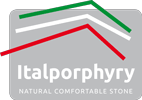The importance of a correct and detailed formulation of the specifications for stone floors
Andrea Angheben – Director of C.I.P.T., Consorzio Italiano Porfido del Trentino – Italporphyry 10/12/2019
The old and good UNI 7998 standard defines the stone floor as “a partial subsystem with the main function of allowing or improving the transit and resistance to loads under certain conditions of use. Its finishing layer gives the flooring predetermined mechanical, chemical and physical performances […] – but also – […] of well-being and safety “.
Porphyry is an undisputed protagonist of urban pavements
In fact, in the public sphere, stone paving is widely chosen for covering roads, squares, parks and sidewalks, and constitutes one of the main elements for furnishing, redeveloping and decorating the urban scene. From this point of view the Trentino Porphyry is an undisputed protagonist with countless virtuous examples of aesthetics and functionality in Italy, in Europe and in the world.
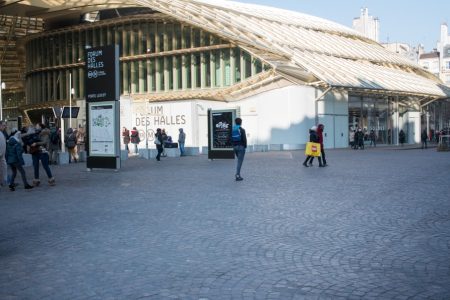
Les Halles, Paris
Unfortunately, however, there are not even bad examples, with uneven or suddenly degraded pavements, which create discomfort, disservices and, what is worse, disaffection of the common citizen towards a material that instead historically has always been used to ennoble the urban landscape.
The causes of the deterioration of porphyry and stone floors in general can be manifold:
- from mechanical and physical stress to the action of frost and de-icing salts;
- from the underestimation of the variables involved to executive or design errors;
- from the use of materials that do not meet the requirements set for the change in the intended use of the work.
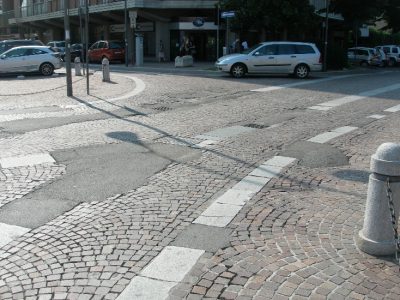
Damaged porphyry road
So what to do to avoid trouble and really create the conditions to ensure that a flooring is durable, resistant … and beautiful?
It would be far too obvious to rely on the concept of the rule of art: an unfortunately obsolete and too vague concept nowadays, now referred to as “icing” in the specifications or dusted off in disputes. The rule of art was valid at the time of the guilds of the arts and crafts which had detailed local regulations regarding the use of specific materials, tools and procedures. Today in a world without borders where stone is extracted and worked in every corner of the globe, the rule of art no longer has a raison d’etre.
It is no coincidence that in the third millennium, the rule of art definitively abdicated in favor of technical standards, i.e. documents approved by recognized national and supranational bodies, which provide guidelines, operating rules and requirements of the materials used, such as to always allow the achievement of the best possible result, in this case of the best possible floor with prerogatives of durability, safety, quality, sustainability and performance.
Since July 2018 the reference regulatory document has been the UNI 11714-1 standard which contains precise indications and codes for installation, for design but also for control and maintenance. It is also obvious that the standard, despite the completeness of the contents, relies on the operators active for the translation on the field of rules and procedures for the construction of the floor, and therefore recognizing roles and responsibilities.
The evolution of the specifications for porphyry floors
In this context, the design is responsible for the delicate task of formulating the specifications. If correct and detailed, the specifications are the main tool to ensure subsequent control by the Works Management and success for the achievement of the requirements of the flooring. On the contrary, if the specifications are superficial or even poorly formulated and not suitable for new materials, or worse, still recovered in copy / paste mode, they can be the main cause of an announced disaster.
Let’s take the case of porphyry and the progressive declinations of the specifications over time, referring to floors with setts.
Until the 80s / 90s, we limited ourselves to designing by really recalling the essentials with the indication of a “Porphyry setts flooring, sealed in cement grout“.
It should be noted that at that time both materials and possible operational choices were to be counted on one hand and the sector manuals they referred to, could provide sufficient elements for the control of the Managing Director during the operational phases of the construction site. It was also not unusual that the pavers’ companies could offer added value to the floor thanks to the quality of the work given by experience, competence and a real tradition recognized in the field.
With the improvement of sector-specific manuals, the specifications in the 90s began to take on a more correct physiognomy: “Supply and installation of porphyry setts flooring, colour tonality at the choice of the Construction Supervision, with natural surface in view and split sides, laid with overlapping arcs on a soft bedding layer of dry premixed sand with type R 3.25 cement at the ratio of kg 10 / m2. The price includes and compensates the charges for the supply of sand, cement, the formation of the slopes necessary for the disposal of rainwater, wetting and the simultaneous beating of sand and cement by means of an adequate mechanical vibrator, the sealing of the joints made with cement and sand grout, subsequent surface cleaning with water jet and sawdust as well as anything else necessary to give the finished work in a workmanlike manner “.
A reference to the rule of the art aside, the descriptive elements introduced provide first concrete indications about the operating methods and mixtures. However, still nothing is said about the traceability of materials and the stress classes with their intended uses. On the other hand, the technical standards were practically ignored even by the sector operators themselves, as well as perfect unknowns were the technical data sheets and material safety data sheets.
And it is precisely towards the end of the 90s that incomplete technical documentation begins to offer interpretative opportunities to the “sly” people and unscrupulous businesses.
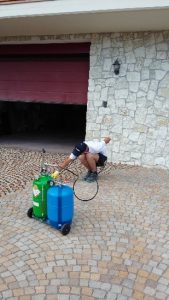
And therefore with the advent and improvement of new operating methods and new materials, such as polyurethane resins and cement based premixes, the superficiality in elaborating the specifications has lent its side to the procedural free will, with all the consequences of the case.
In particular, the floor with setts and polyurethane resin joints has too often been described using the entry of the cement grout floor and adding at the end the only increase in costs for the sealing of the joints. Ignoring the fact that, for example, sand is not foreseen for the resin, nor is it a dry mix with cement. Not to mention the jet of water and the sawdust, and above all underestimating that the resin must have specific, clearly identifiable properties and be dispensed with special equipment. A circumstance that creates confusion, can lead to error, prevents correct control during the construction phases, and actually alters the correct cost analysis.
And so?
Fortunately, the UNI 11714-1 standard was developed by a working group made up of producers of natural stone and products for laying and maintenance, trade associations and test laboratories, with the contribution of universities and services for the design. The standard contains all the elements that the designer can recall, hopefully supported by a healthy face-off with the manufacturers, in the formulation of complete, indisputable and functional specifications for achieving the flooring requirements.
The following table shows the complete specifications relating to porphyry setts floors sealed with polyurethane resin. The first part shows the text of the specifications. The second part shows the references and ideas attributable to UNI 11714-1 and / or sector technical manuals.
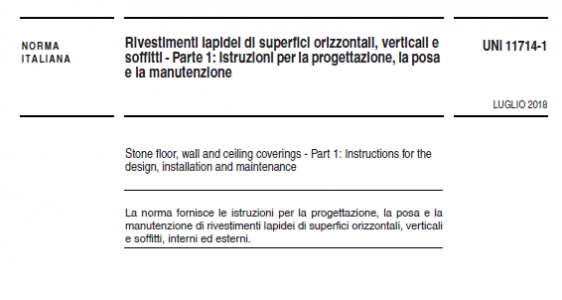
Specifications
FLOORING IN PORPHYRY CUBES WITH SEALING OF GROUTS IN POLYURETHANE RESIN -stress class P9
Supply and installation of Trentino porphyry flooring in accordance with the characteristics of the Trentino Controlled Porphyry Brand (1) made of setts with natural quarry surface, split sides, laid with overlapping arcs (or parallel rows) on a bedding layer consisting of crushed magmatic rock (Los Angeles test <20%) (2), clean and dry in suitable grain size 3/6mm and a correct thickness of 5/6 cm maximum. Once the setts have been laid, the joints must be filled with the same inert draining bedding followed by the normal phase of constipation and mechanical vibration. This includes then the further clogging of the joints with crushed rock of the same grain size or with a perfectly clean and dry 2/4 mm lower grain size, the subsequent pouring of polyurethane resin in compliance with the requirements and registered according to the Reach Regulation (EC) (3), manually poured in each leak with a system consisting of a controlled pressure cylinder (maximum 3 bar) and injector for low risk dispensing of any violent spills (4). The polyurethane resin used must be free of solvents and flammable substances (5), with a characteristic odor and suitable for disposal or recycling according to the regulations in force on special non-hazardous waste, supported by documentation with specific certifications; mixed with the sealing stone, the polyurethane resin must provide precise indications of conductivity and draining permeability according to the provisions of UNI EN 12697 – 40 (6). The porphyry material must be supplied with a Declaration of Performance and CE marking, as required by Regulation 305/2011, and by UNI EN 1342, with updated performance data (7). The price includes and compensates the charges for the supply and installation of the laying bed, the formation of the slopes necessary for the disposal of rainwater, the simultaneous beating by means of an adequate mechanical vibrator (8), the possible replacement of broken or damaged setts during work in progress, sealing the interstices with resin and anything else necessary to give the finished work in accordance with the UNI 11714-1 technical standard for stress class P9 (9). Setts size 8/10 cm (minimum coverage 180 kg / m2) (10) ..
REFERENCES TO REGULATIONS AND / OR TO THE TECHNICAL MANUALS OF THE SECTOR
- The Trentino Controlled Porphyry Trade Mark Regulation, referred to in all the items of the LL.PP price list of the Province of Trento, is a voluntary system born in 1995 with the aim of providing certainties for the quality of the products to public and private designers and clients. It is a product brand, not a corporate one and is obtained through periodic production checks carried out by specialized personnel with the preparation of result reports available at request. The Resolution of the Provincial Council n. 2051 of 19.10.2018 approved the requirements of the new quality mark for porphyry and Trentino stones, and it is currently awaiting imminent implementation.
- The crushed rock to be used in the laying bed must have a Los Angeles test value <20%. From this point of view, Trentino porphyry is an ideal stone, as are other magmatic rocks such as granite and basalt.
- The safety data sheets of the polyurethane resin contain all the identification and performance elements. As a chemical product, it must comply with the requirements of the REACH Regulation (EC).
- The injector must ensure the dispensing of the polyurethane resin in safe conditions for both operators and users, and therefore must be equipped with a pressure reducer.
- The isocyanate-based resin must contain a diluent instead of a solvent for the protection, safety and health of the users. The solvent, on the contrary, activates the harmful components of the isocyanate, favoring its inhalation. The diluent eliminates the risk of flammability of the product. If the resin contains solvent, it can create dangerous conditions not only during the dispensing phase but also and above all during the transport and storage phase.
- To measure the draining capacity now, since no specific criterion is provided, we rely on test methods borrowed from other materials.
- The European standards on stone materials require that the stone is always accompanied by the Declaration of Performance with indications for traceability. The standard also provides for the timing for the renewal of technical tests, every two or ten years.
- The reference to the vibro-compacting machine is essential to ensure maximum compaction of the setts floor. By way of example, in the case of 8/10 setts, the minimum compactor weight is approximately 200 kg – 30 kN or 350 kg – 40 kN.
- The stress class P9, according to UNI 11714-1: 2018 identifies: urban roads, roads with preferential lanes of public transport or with obligatory routes, high-traffic roads, roundabouts, speed bumps and bollards.
- The indication of the coverage of the material is essential to prevent the contractor from supplying material with a “lowered” thickness, and therefore such as to alter the classification and resistance of the floor.
As mentioned above, it is clear that the task of designing, even in the field of stone flooring, is not the simplest. Especially when the projects are particularly complex and involve different destinations of use and different degrees of stress, and / or different operating solutions with differentiated use, for example, of cement and resin premixes. Even more, if there is also a mixture of stone materials in specific formats and sizes, each with its own physical and mechanical characteristics.
But this is the only way forward to achieve the quality and technical standards of stone paving and certainly the manufacturers do not have to stand by. On the contrary, as an active part in the realization of a stone floor, they must rather be the “architects” of a healthy and constructive collaboration made of technical assistance, competence and sincere transparency, at the service of the designer and of the Project Supervisor.
